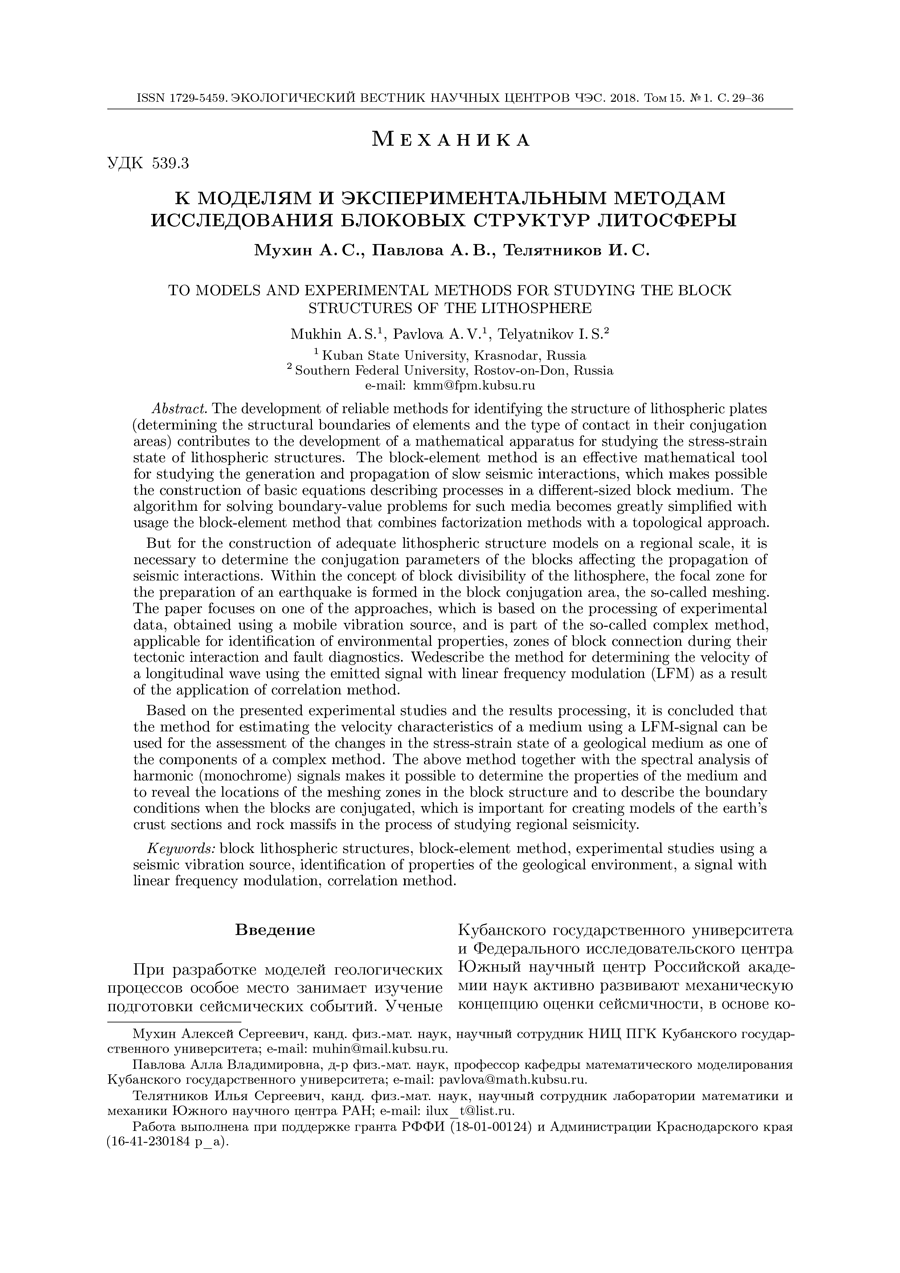To models and experimental methods for studying the block structures of the lithosphere
UDC
539.3DOI:
https://doi.org/10.31429/vestnik-15-1-29-36Abstract
The development of reliable methods for identifying the structure of lithospheric plates (determining the structural boundaries of elements and the type of contact in their conjugation areas) contributes to the development of a mathematical apparatus for studying the stress-strain state of lithospheric structures. The block-element method is an effective mathematical tool for studying the generation and propagation of slow seismic interactions, which makes possible the construction of basic equations describing processes in a different-sized block medium. The algorithm for solving boundary-value problems for such media becomes greatly simplified with usage the block-element method that combines factorization methods with a topological approach. But for the construction of adequate lithospheric structure models on a regional scale, it is necessary to determine the conjugation parameters of the blocks affecting the propagation of seismic interactions. Within the concept of block divisibility of the lithosphere, the focal zone for the preparation of an earthquake is formed in the block conjugation area, the so-called meshing. The paper focuses on one of the approaches, which is based on the processing of experimental data, obtained using a mobile vibration source, and is part of the so-called complex method, applicable for identification of environmental properties, zones of block connection during their tectonic interaction and fault diagnostics. Wedescribe the method for determining the velocity of a longitudinal wave using the emitted signal with linear frequency modulation (LFM) as a result of the application of correlation method. Based on the presented experimental studies and the results processing, it is concluded that the method for estimating the velocity characteristics of a medium using a LFM-signal can be used for the assessment of the changes in the stress-strain state of a geological medium as one of the components of a complex method. The above method together with the spectral analysis of harmonic (monochrome) signals makes it possible to determine the properties of the medium and to reveal the locations of the meshing zones in the block structure and to describe the boundary conditions when the blocks are conjugated, which is important for creating models of the earth's crust sections and rock massifs in the process of studying regional seismicity.
Keywords:
block lithospheric structures, block-element method, experimental studies using a seismic vibration source, identification of properties of the geological environment, signal with linear frequency modulation, correlation methodAcknowledgement
References
- Popkov, V.I. Scaly-thrust structure of the North-Western Caucasus. Rep. of the Academy of Sciences, vol. 411, no. 2, pp. 223-225. (In Russian)
- Vorovich, I.I., Babeshko, V.A. Dynamic mixed problems of elasticity theory for nonclassical domains. Nauka, Moscow, 1979. (In Russian)
- Vorovic,h I.I., Babeshko, V.A., Pryakhina, O.D. Dynamics of massive bodies and resonant phenomena in deformable media. Nauchniy mir, Moscow, 1999.
- Babeshko, V.A., Mukhin, A.S., Babeshko, O.M., Evdokimova, O.V., Grischenko, D.V., Shestopalov, V.L. On some properties of seismic traces. Ecological bulletin of scientific centers of the Black Sea Economic cooperation, 2012, no. 3, pp. 12-17. (In Russian)
- Ilyukhin, S.R., Shestopalov, V.L. Study of the geodynamics of the Crimea - Western Caucasus region using GPS measurements. Izvestiya Vuzov "Geodesy and aerophotography", 2007, no. 3, pp. 9-17. (In Russian)
- Vartanyan, G.S. Some deformation mechanisms of functioning of endodrenage system of the Earth and seismicity. Otechestvennaya geologiya [Domestic geology], 2008, no. 2, pp. 18-27. (In Russian)
- Mukhin, A.S., Pavlova, A.V., Telyatnikov, I.S. To methods of investigation of block lithospheric structures. Ecological bulletin of scientific centers of the Black Sea Economic cooperation. 2017, no. 1, pp. 65-73. (In Russian)
- Babeshko, V.A., Babeshko, O.M., Evdokimova, O.V., Zaretskaya, M.V., Pavlova, A.V. Differential factorization method for block structure. Rep. of the Academy of Sciences, 2009, vol. 424, no. 1, pp. 36-39. (In Russian)
- Babeshko, V.A., Evdokimova, O.V., Babeshko, O.M. Some common properties of block elements. Rep. of the Academy of Sciences, 2012, vol. 442, no. 1, pp. 37-40. (In Russian)
- Babeshko, V.A., Evdokimova, O.V., Babeshko, O.M. Topological method for solving boundary value problems and block elements. Rep. of the Academy of Sciences, 2013, vol. 449, no. 6, pp. 657-660. (In Russian)
- Babeshko, V.A., Evdokimova, O.V., Babeshko, O.M. To the problem of the physico-mechanical forerunner of the initial earthquake: place, time, intensity. Rep. of the Academy of Sciences, 2016, vol. 466, no. 6, pp. 664-669. (In Russian)
- Babeshko, V.A., Babenko, G.V., Mukhin, A.S. Patent for invention no. 2118806. Vibrating stand. Priority of 24.07.1996. (In Russian)
- Baskakov, S.I. Radio engineering circuits and signals. Vysshaya shkola, Moscow, 1988. (In Russian)
- Gurvich, I.I. Seismic exploration. Nedra, Moscow, 1970. (In Russian)
Downloads
Submitted
Published
How to Cite
Copyright (c) 2018 Mukhin A.S., Pavlova A.V., Telyatnikov I.S.

This work is licensed under a Creative Commons Attribution 4.0 International License.




